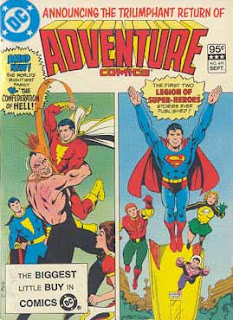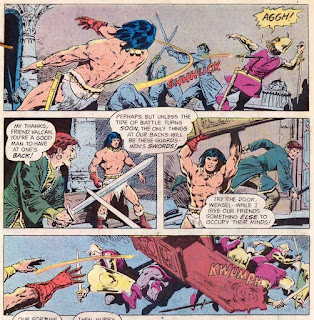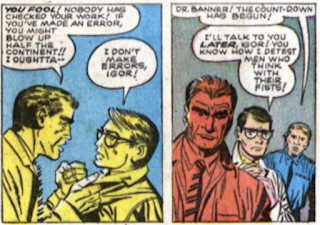I'm reading DC Comics' output from January 1980 (cover date) to Crisis! Today, I'm looking at the comics at newsstands on the week of June 3, 1982.

Adventure Comics #491: Adventure returns as a digest of mostly reprints, but there's a new Captain Marvel story by Bridwell and Newton. Satan assembles Ibac, Sabbac, Master Man and Darkling to get rid of the Marvel Family and Kid Eternity. The heroes are on a hike when it gets uncommonly dark. Realizing Darkling is responsible, the Marvels try to transform, but the darkness is so intense even magic lightning can't get through. Having been given the power to see in magical darkness, Master Man puts his hand over Kit Freeman's mouth before he can use his power. Billy Batson tricks Sabbac into conjuring a flaming light and Kit uses it to burn the gag from his mouth and says his magic word. He summons Zeus, who brings along three Shazam lightning bolts for the Marvels. Ibac, Sabbac and Darkling are defeated, but Master Man summons four gods of evil.

Arak Son of Thunder #13: Thomas and Colon/Acala continue Arak's adventures in Greece. A chance encounter with some dead monks and soul-taking Keres demons, leads to Satyricus and Arak impersonating the monks at a monastery and agreeing to investigate a story of demonic influence in some neighboring caves. Inside the cave, the satyr mysteriously falls asleep, and a swooping Keres causes Arak to become lost. He finds a thread which leads him to a tapestry which depicts his native land and He-No the god of thunder.
In the Valda backup by the Thomases and Colon, the gifts of treacherous Hun ambassadors are ensorcelled and meant to harm the Charlemagne. Valda prevents the king's own sons from killing their father who they perceive as a stag thanks to the magic. She destroys the cursed helmet, and the king plans to punish the huns for their treachery. It's interesting how different Colon's art looks here when he inks it himself compared to the main story with Alcala inks. This is more cartoony and cleaned lined, and the other grittier.

DC Comics Presents #49: Thomas/Kupperberg and Buckler bring Black Adam and Captain Marvel over from Earth-S for a team-up with an unusual angle. After a terrorist bomb shakes an ancient Egyptian temple, the Billy Batson of Earth-One has a dream about becoming Captain Marvel. Black Adam turns up on Earth-One intent on conquest, and Superman needs Captain Marvel's help, but he'll need Billy Batson and the secrets of the temple to get him here.
Fury of Firestorm #4: Conway and Broderick/Rodriquez have Firestorm at the mercy of Killer Frost, lest the people of New York suffer. Her first demand: bring her actor Curt Holland (a Burt Reynolds stand-in) to be her consort. Firestorm heads off to do that, but first has a pointless but Marvel-style fight with his teammates in the JLA who want to help, but won't let Firestorm do it, his way. Eventually, they talk it out and collaborate with Ronnie on a plan involving a device built by Stein and Red Tornado impersonating Holland. It works, and Frost is defeated.
Justice League #206: Conway is joined by Infantino for this one with Tanghal's inks reining in some of the excesses we see in his work on Flash. In the 25th Century, Thomas Parker recounts to his son one of the Justice League's adventures, while the two visit an exhibit in the JLA's honor in the Space Museum. Unknown to the League, the demons Abnegazar, Rath, and Ghast had caused the mystic Jar, Bell and Wheel used to imprison them to be left behind in the Souvenir Room of the original Secret Sanctuary when the Justice League moved to their satellite headquarters. The artifacts were eventually discovered and used to free the demons from their crypts. The demonic trio attacked the satellite and then battled the heroes a second time at Stonehenge. They trick Zatanna into using her magic to destroy the 3 objects that can imprison them, but they are defeated when she uses her magic to recreate the Jar, Bell, and Wheel and imprison them again.
I've said before Conway's run here is generally good, but uneven, and this is one of the less good issues. It feels like a Silver Age throwback, and not just for Infantino's art.

Sgt. Rock Annual #2: Kanigher and Spiegle have Rock sent on a special mission to rescue a man with sensitive information who has fallen into German hands--and if he doesn't think he can rescue him, Rock is to kill him. A hard enough assignment any time, but harder still because the man in question is Rock's younger brother. With the help of the Haunted Tank crew and Mademoiselle Marie, a handpicked group of Easy rescue Larry Rock, though a rogue's gallery of villains get in their way: the Iron Major, Helga Voss, and a over-sized robot called the Goliath of the Western Front. Larry's been tortured and has a head trauma causing him pain. He wants desperately not to fall into German hands again. He attempts to get Rock to kill him, and when he won't, Larry jumps from the top of a cable car in the mountains. Rock tries to save him, but can't keep a grip. Mission completed, Rock and his men return to Easy. This was a good one, justifying the extra-page count, I thought.
Weird War Tales #114: Kanigher and Carillo bring back G.I. Robot (JAKE-2) with a cameo by the Creature Commandos. I suppose the story is a silly if you think about it, but I also feel like it's probably the most poignant of the week, even moreso that Kanigher's other effort Sgt. Rock. There is pathos in Sgt. Coker's devotion to his robot "buddy," in a way perhaps more now than in its era. JAKE always seems to have some humanity, but his mute, inexpressiveness never allows you to know whether it's an expression of his soul or just his programming, when he sacrifices himself for others or even puts his arm around a frightened princess.
Wonder Woman #295: Thomas/Mishkin and Colan/McLaughlin are keeping it topical with this storyline about a nefarious video game. Wonder Woman stops a riot in a department store caused by a rush of people trying compulsively to pick-up the Commander Video. The villain here, the Sandman foe last seen in 1974, General Electric, is in prison, but he has taken over the mind of the warden and many others by means of his game. Electric contacts General Darnell, another of his mind controlled lackeys, and has him transfer bombers and nuclear missiles to the prison just as Wonder Woman bursts in after destroying Steve's Commander Video game. She attacks Darnell, but the controlled general brands her a traitor, and she's on the run to try and stop the weapons transfer. Her jet takes a hit from a missile at the transfer site, and she falls unconscious and into the hands of the military.
In the Huntress backup, Alfred has been poisoned by a unknown, time-release toxin by a mobster out for revenge. When threatening the life of the thugs responsible doesn't yield any useful information, she rushes him to the hospital. Not knowing what the toxin is, the doctors don't know what to do. A desperate Huntress decides to science this herself. After all, she watched her dad do this sort of thing and she's had "two courses in organic chemistry." This being a comic, she's successful and Alfred lives.

































